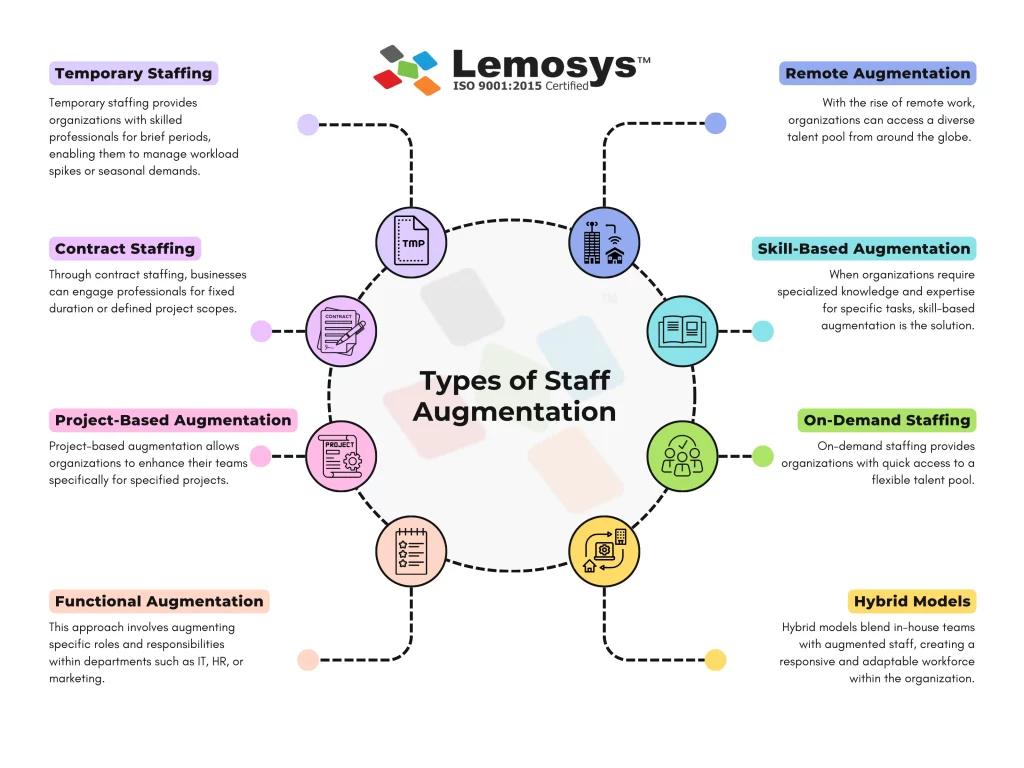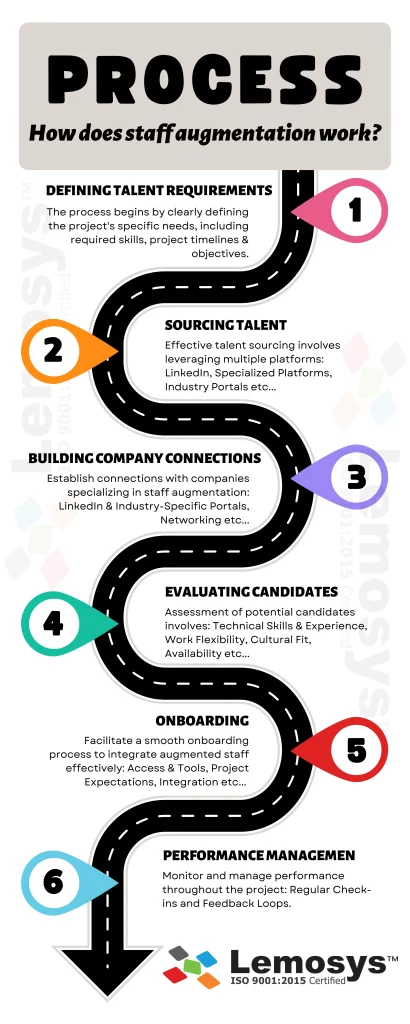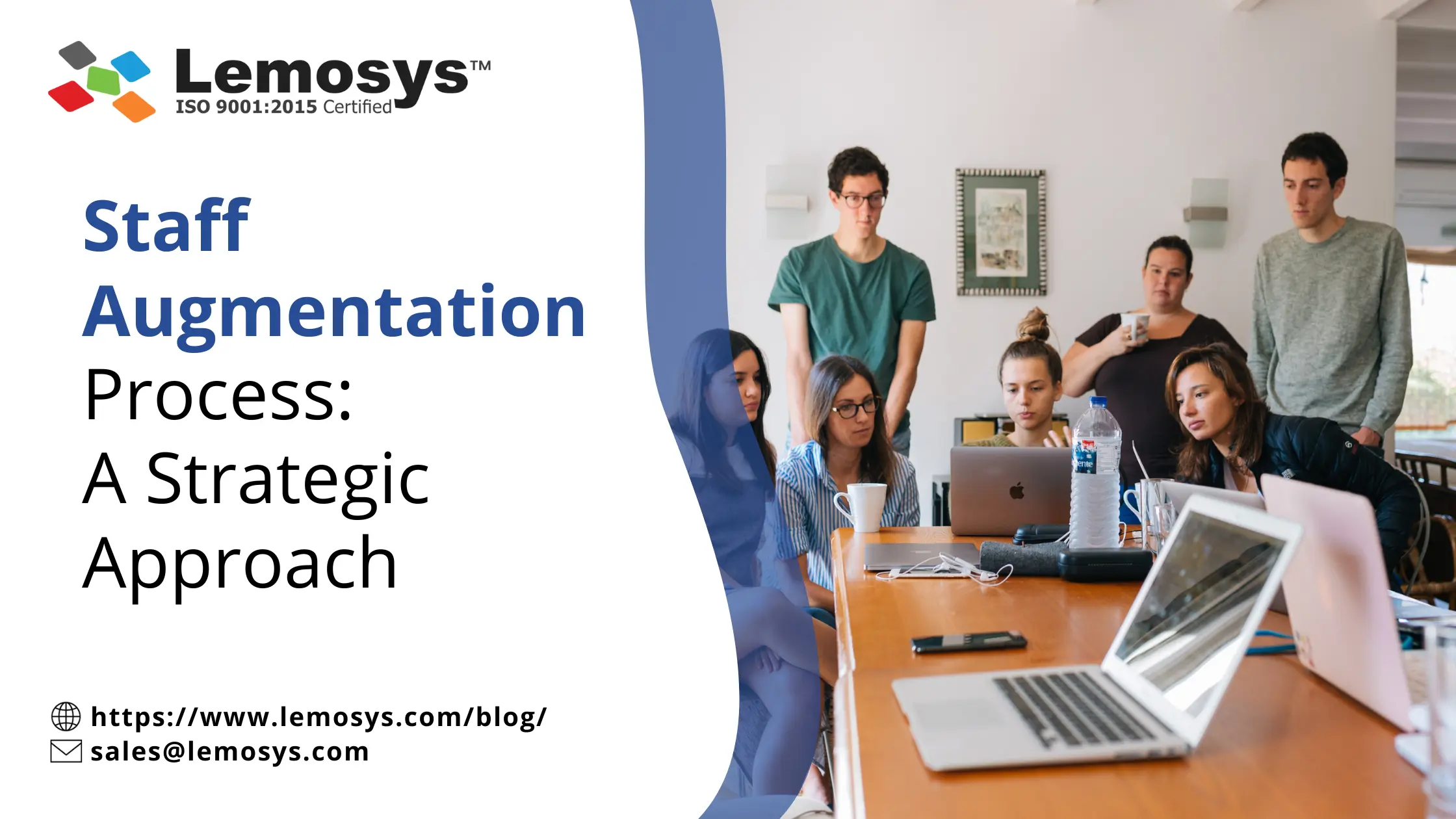In an era defined by rapid technological advancement and evolving market demands, businesses must remain agile to succeed. One key strategy organizations are adopting is staff augmentation – an approach that provides access to a highly skilled workforce on a contractual basis.
Whether on-site or remote, this method allows businesses to meet their staffing needs without the long-term commitment of permanent hires.
This blog dives into what staff augmentation is, the process behind it, and how it empowers organizations to thrive in today’s dynamic business environment.
Staff Augmentation Meaning
A flexible workforce model that involves hiring temporary of IT workers to fill short-term positions in a company.
Table of Contents
What is Staff Augmentation?
Staff augmentation refers to the practice of temporarily integrating external professionals into a company’s workforce to meet specific project requirements. These external resources are typically brought in for their specialized skills and can work alongside the company’s permanent employees, ensuring seamless project execution.
Businesses often engage in contract-based agreements to hire augmented staff for a fixed duration, thus avoiding the long-term commitments associated with full-time hiring.
The professionals provided through staff augmentation can either work on-site, integrating directly with the team, or remotely, depending on the nature of the project and the company’s needs.
Staff Augmentation – How Does It Work?
Imagine needing extra hands for a critical project or expertise in a niche area. Staff augmentation allows you to bring in seasoned professionals who blend seamlessly with your current team, delivering results without the lengthy recruitment process.
Whether it’s a short-term surge or a specialized task, IT staff augmentation provides the expertise you need, precisely when you need it.
Types of Staff Augmentation and Strategic Advantages

In today’s fast-paced business environment, staff augmentation has emerged as a vital strategy for organizations seeking to enhance their operational flexibility and access specialized expertise in technology. This approach allows companies to scale their teams according to project demands while minimizing the long-term commitments associated with permanent hires.
Below, we delve into the key types of staff augmentation and their strategic benefits.
1. Temporary Staffing
Short-term Solutions for Peak Demands
Temporary staffing provides organizations with skilled professionals for brief periods, enabling them to manage workload spikes or seasonal demands. This strategy helps to maintain productivity without the financial burden of permanent hires.
2. Contract Staffing
Focused Expertise for Specific Projects
Through contract staffing, businesses can engage professionals for fixed duration or defined project scopes. This model is ideal for acquiring specialized skills tailored to particular initiatives, ensuring projects are completed effectively.
3. Project-Based Augmentation
Tailored Teams for Targeted Objectives
Project-based augmentation allows organizations to enhance their teams specifically for specified projects. By bringing in experts aligned with project goals, businesses can drive to innovation and achieve superior results.
4. Functional Augmentation
Strengthening Core Operations
This approach involves augmenting specific roles and responsibilities within departments such as IT, HR, or marketing. Functional augmentation ensures that critical operations remain robust and effective, allowing organizations to focus on their core missions.
5. Remote Augmentation
Global Talent at Your Fingertips
With the rise of remote work, organizations can access a diverse talent pool from around the globe. Remote augmentation not only reduces overhead costs but also allows companies to tap into specialized skills and capabilities that may not be available locally.
6. Skill-Based Augmentation
Niche Expertise on Demand
When organizations require specialized knowledge and expertise for specific tasks, skill-based augmentation is the solution. This approach allows businesses to hire experts—such as cybersecurity professionals or data analysts—temporarily, addressing immediate needs without long-term commitments.
7. On-Demand Staffing
Agility and Flexibility
On-demand staffing provides organizations with quick access to a flexible talent pool. This model allows businesses to respond rapidly to changing needs, making it an invaluable resource in today’s dynamic marketplace.
8. Hybrid Models
Combining In-House and Augmented Talent
Hybrid models blend in-house teams with augmented staff, creating a responsive and adaptable workforce within the organization. This strategy enhances operational agility while maintaining a cohesive team culture.
Types of Staff Augmentation Services
Staff augmentation services can be categorized into several types based on the specific needs of businesses.
Here are some common types:
| Type of Service | Description / Details |
| IT Staff Augmentation | Provides skilled IT professionals, including developers and network engineers, to bridge gaps or support projects. |
| Creative Staff Augmentation | Supplies creative talents such as graphic designers and content creators to elevate marketing and branding initiatives. |
| Administrative Staff Augmentation | Delivers administrative support through virtual assistants and office managers, optimizing operational efficiency. |
| Finance and Accounting Augmentation | Offers finance professionals like accountants and financial analysts for assistance with reporting and compliance. |
| Engineering Staff Augmentation | Supplies engineers across various disciplines to tackle specialized projects requiring technical expertise. |
| Healthcare Staff Augmentation | Provides healthcare professionals such as nurses and therapists to address temporary staffing needs in medical settings. |
| Customer Support Augmentation | Supplies customer service representatives to manage increased call volumes and enhance customer interactions. |
| Legal Staff Augmentation | Offers legal professionals, including paralegals and contract lawyers, to assist with specific legal matters. |
| Project-Based Augmentation | Focuses on hiring experts for defined projects, ensuring access to specialized skills as required. |
| Remote Staff Augmentation | Provides remote professionals who can work from any location, offering flexibility and a wider talent pool. |
How To Choose the Right Staff Augmentation Services?
Selecting the right staff augmentation service is crucial for enhancing your project’s success. Here’s a streamlined guide to help you make an informed choice:
1. Define Your Specific Needs
- Skill Set: Identify the specific expertise required.
- Duration: Determine if you need short-term or long-term support.
- Integration: Decide if the staff will work on-site or remotely.
2. Research Potential Providers
- Industry Experience: Look for providers with a proven track record in your field.
- Client Testimonials: Read reviews and case studies to gauge their reliability.
3. Evaluate Expertise and Specialization
- Technical Skills: Ensure they can provide specialists with the required qualifications.
- Portfolio: Review examples of their previous work.
4. Understand Cost Structures
- Transparent Pricing: Look for clear pricing structures with no hidden fees.
- Value for Money: Assess the overall value relative to the cost.
5. Onboarding Process
- Efficiency: Investigate how quickly they can onboard new staff.
- Support: Check what resources they provide during onboarding.
6. Cultural Fit
- Communication Style: Ensure their approach aligns with your company culture.
- Work Ethic: Look for compatibility in working culture.
7. Legal Compliance
- Clear Contracts: Confirm that contracts outline roles and responsibilities.
- Regulatory Adherence: Ensure they align with relevant laws and standards.
8. Ongoing Support
- Performance Monitoring: Check if they have systems to evaluate staff performance.
- Post-Engagement Assistance: Inquire about support after project completion.
9. Technology Compatibility
- Tech Stacks: Ensure staff are proficient in your tools and technologies.
- Collaboration Tools: Look for effective communication solutions.
Staff Augmentation vs. Outsourcing: Key Differences
While both staff augmentation and outsourcing are aimed at addressing workforce challenges, they differ significantly in their approach and execution:
Staff Augmentation:
- The company retains full control over the project and its execution.
- External professionals work alongside the existing team, becoming an integral part of the company’s operations during their contract.
- Allows for greater flexibility and integration, ensuring cultural alignment and real-time collaboration with the internal team.
Outsourcing:
- The entire project or specific tasks are handed over to an external service provider.
- The external vendor takes over project management and execution, often working independently from the company.
- Less control over the process and delivery, but it can be more cost-effective for long-term, ongoing tasks.
IT Staff augmentation provides more control and integration compared to outsourcing, making it ideal for businesses that want flexibility without relinquishing project oversight.
Staff Augmentation vs. Consulting: A Comparative Analysis
Another common workforce strategy is consulting, but how does it differ from IT staff augmentation?
Staff Augmentation:
- Augmented staff become temporary team members, working alongside internal employees to fulfill specific project needs.
- Focuses on providing operational support by integrating external professionals directly into the company’s workflow.
- The company maintains full control over project execution and management.
Consulting:
- Consultants are typically hired to provide expert advice on strategy, direction, or process improvements, rather than to execute tasks directly.
- Consulting engagements are more strategic in nature, with the consultant guiding the company on how to approach and solve issues.
- Consultants do not typically integrate into day-to-day operations as augmented staff do.
In summary, while IT staff augmentation fills immediate operational gaps, consulting focuses on strategic guidance and high-level advice. Both are valuable, but they serve different purposes in the overall business strategy.
What is a Staff Augmentation Contract?
A staff augmentation contract is a formal agreement signed between the vendor (the company providing the staff) and the client (the company seeking additional staff). This contract serves to establish the terms and conditions under which the two companies will collaborate, ensuring that both parties are aligned on their expectations and responsibilities.
Staff Augmentation Agreement
1. Scope of Work
- Description: A comprehensive outline of the tasks, responsibilities, and deliverables expected from the augmented staff. This section defines the specific roles and objectives.
- Objectives: Clear goals and outcomes to be achieved through the engagement.
2. Contract Duration
- Term: Effective dates, including the commencement and conclusion of the contract.
- Extension and Termination: Conditions under which the contract may be extended or terminated, including any required notice periods.
3. Compensation and Payment Terms
- Rates: Agreed-upon rates for services rendered, whether hourly, daily, or fixed fees.
- Payment Schedule: Timelines for invoicing and payment, including any conditions for late payments.
4. Performance Metrics
- Evaluation Criteria: Key performance indicators (KPIs) and benchmarks for assessing the performance of the augmented staff.
5. Confidentiality and Non-Disclosure
- Protection of Information: Obligations to safeguard sensitive and proprietary information, with clear non-disclosure terms.
6. Intellectual Property Rights
- Ownership: Provisions regarding the ownership of any intellectual property developed during the engagement.
7. Compliance and Legal Obligations
- Adherence: Requirements for compliance with applicable laws, regulations, and industry standards.
8. Termination Clauses
- Conditions: Specific conditions for early termination of the contract, including notice requirements and any related obligations.
9. Liability and Insurance
- Responsibility: Definitions of liability for any damages or losses incurred, and insurance requirements to cover potential risks.
10. Dispute Resolution
- Resolution Process: Procedures for addressing and resolving disputes, including mediation and arbitration options.
11. Responsibilities of Parties
- Client Responsibilities: Obligations of the client, including any support, resources, or access required for the successful engagement.
- Provider Responsibilities: Duties and expectations for the staff augmentation provider.
12. Conflict of Interest
- Disclosure: Requirements for disclosing and managing potential conflicts of interest to ensure impartiality and integrity.
Vendor Requirements: On-Site and Remote Talent
One of the key advantages of staff augmentation is the ability to fulfill both on-site and remote workforce needs. Vendors often have a mix of requirements, from needing professionals physically present for tasks requiring close collaboration, to hiring remote specialists for roles that can be performed from anywhere in the world.
Staff augmentation allows businesses to access the talent they need, regardless of geographical constraints, ensuring projects move forward efficiently.
Staff Augmentation Process: A Strategic Approach

1. Defining Talent Requirements
The process begins by clearly defining the project’s specific needs, including required skills, project timelines, and objectives. This involves determining the ideal candidate profile, whether it’s a freelancer, specialized professional, or IT staff augmentation expert.
2. Sourcing Talent
Effective talent sourcing involves leveraging multiple platforms:
- LinkedIn: Identify and connect with professionals and freelancers with the required skills.
- Specialized Platforms: Explore Behance, Truefirms, and WellFound for job postings and professional portfolios.
- Industry Portals: Utilize platforms to discover businesses providing remote or contractual work opportunities.
3. Building Company Connections
Establish connections with companies specializing in staff augmentation:
- LinkedIn & Industry-Specific Portals: Search for and engage with companies offering IT staff augmentation services.
- Networking: Foster partnerships to expand your talent pool and streamline access to qualified professionals.
4. Evaluating Candidates
Assessment of potential candidates involves:
- Technical Skills & Experience: Ensure candidates possess the necessary expertise and background.
- Work Flexibility: Verify their ability to work on-site or remotely as per the project’s needs.
- Cultural Fit: Assess alignment with your team’s culture and values.
- Availability: Confirm their capacity to meet project deadlines.
5. Onboarding
Facilitate a smooth onboarding process to integrate augmented staff effectively:
- Access & Tools: Provide necessary resources and tools.
- Project Expectations: Clearly communicate roles and expectations.
- Integration: Embed them into the team’s workflow to ensure minimal disruption and maximum productivity.
6. Performance Management
Monitor and manage performance throughout the project:
- Regular Check-ins: Conduct periodic reviews to track progress.
- Feedback Loops: Offer constructive feedback to align with project goals and expectations.
By following this structured approach, organizations can ensure the effective deployment of staff augmentation resources, maximizing project success and operational efficiency.
Why Choose Contract-Based Staff Augmentation?
Staff augmentation offers several key advantages, particularly when professionals are provided on a contractual basis:
- Flexibility: Organizations can easily adjust their workforce size based on project needs, hiring on-site or remote professionals as required.
- Access to Specialized Skills: Whether for IT, project management, or industry-specific expertise, staff augmentation provides access to highly skilled professionals without the need for long-term employment.
- Cost Efficiency: Contract-based hiring avoids the overhead costs of full-time employees, such as benefits, insurance, and other long-term commitments.
- Scalability: Staff augmentation allows businesses to respond to sudden increases in workload or new market opportunities without the delays of traditional hiring processes.
The Role of Portals in Staff Augmentation
In addition to LinkedIn, various platforms facilitate the staff augmentation process by connecting businesses with the right professionals. LinkedIn, Truefirms, and WellFound are just a few examples of portals where organizations can post and find remote or contractual job opportunities.
These platforms offer not only a place to search for individuals but also allow businesses to monitor company posts, especially those seeking IT staff augmentation services. This creates a comprehensive approach to talent sourcing, where organizations can connect with other companies and professionals, expanding their network and ensuring project success.
Conclusion
As businesses face increasing pressure to stay competitive, staff augmentation provides a flexible and efficient solution to meet workforce demands. For companies seeking rapid growth or flexible project support, Lemosys Infotech delivers an unparalleled solution. Imagine having a skilled development team, perfectly aligned with your needs, ready to start in just 30 minutes.
By utilizing platforms like Behance, Truefirms, and WellFound, businesses can easily find the talent they need while also connecting with companies that specialize in IT staff augmentation services.
Signing a IT staff augmentation contract before collaborating as a registered vendor ensures both parties are aligned on terms and conditions, protecting confidential data, including company resources and payment terms, and ensuring a seamless and secure partnership.
Our intelligent staffing approach ensures that every professional is rigorously vetted and matched to your exact requirements. With Lemosys Infotech, you can effortlessly scale your team without sacrificing quality or efficiency – keeping your business agile and primed for success in today’s fast-paced market.

